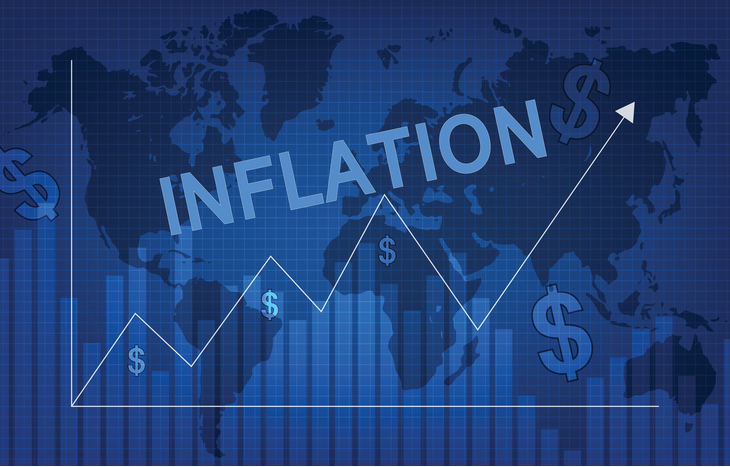Is Inflation Bad for Stocks?
Inflation has been the number one financial buzzword of 2022 and for good reason. According to data from the U.S. Consumer Price Index (CPI), the inflation rate skyrocketed to 7.5% in January 2022 and remains at levels not seen since 1982. Not coincidentally, there was a minor recession during 1981-1982, due largely in part to tight monetary policy in an effort to fight mounting inflation.
Looking at the stock chart from the early 1980s, it begs the question: is inflation bad for stocks? From January 1981 to June of 1982, the Dow Jones Industrial Average (DOW) lost roughly a quarter of its value as stocks took a tumble. As we face similar circumstances, investors have begun to look at their portfolios with trepidation. It doesn’t help that the market is negative year-to-date.
Is inflation bad for stocks? That depends on which stocks you’re holding and your investment strategy. Here’s what investors need to think about as they battle rising prices in 2022.

Is Inflation Bad for Stocks and Other Investments?
In simplest terms, inflation is a loss of value. As the dollar loses value, investors lose purchasing power and see diminished returns from positions they choose to exit. For instance, 7.5% inflation means that for every $100 an investor gains, they only realize $92.50. This disparity can add up quickly—especially for stocks held long-term.
Often, the best bet against inflation is to stay invested. Yet, this presents another problem. Investors are likely to find themselves paying more for stocks that might still be overvalued.
Take a company like Block Inc. (NYSE: SQ). The company is down 50% from its 52-week highs and looks attractive at its current price. However, the company has a staggering price-to-equity ratio of 446 and a price-to-free cash ratio of 100. By fundamental valuation metrics, Block Inc. is wildly overpriced. Investors buying in at current levels may feel like they’re getting a deal, but they’re likely overpaying; and purchasing 7.5% less thanks to inflation. It’s a double-whammy that investors need to beware of.
Inflation also takes the form of ballooning revenues, which will decline when inflation does. Home Depot Inc. (NYSE: HD) offers a great example. According to the company’s most recent earnings call, the hardware giant saw double-digit comp growth in 2021, on top of nearly 20% comp growth in 2020, amounting to $40 billion total. It previously took the company nine years (2009 to 2018) to foster that same level of growth. This unsustainable level of revenue growth will begin to fall once inflation does.
In short, inflation affects the value of every dollar spent or earned. Investors need to stay mindful of exactly how it affects them based on their position as a buyer or seller of equities, and how inflation factors into each company’s performance.
Pay Attention to the Misery Index
Another buzzword that’s making headlines in 2022 is “stagflation:” a combination of unemployment and inflation. The result of stagflation often manifests in company performance: the inability to staff appropriately and the need to spend more on human capital via wage increases, retention bonuses and additional payroll costs.
To understand how stagflation affects stocks, investors should turn their attention to the Misery Index: a measure of economic distress equal to the sum of inflation and unemployment rate. It’s an imprecise metric, yet nonetheless a useful tool for looking at how everyday economic circumstances affect stock performance.
Typically, the ideal number for the Misery Index is 6-7% or lower. This assumes a nominal inflation rate of 2-3% and employment of roughly 4%: both indicative of a healthy economy. Generally speaking, the higher the Misery Index, the more volatility and the lower the returns investors can expect. Given current inflation (7.5%) and unemployment figures (3.8%), the Misery Index stands at roughly 11-12%.
Looking at Inflation-Proof Stocks
Inflation disproportionately affects some companies more than others. Investors need to be mindful of each company’s sector and business model when considering their own portfolios or future positions. For example, businesses with less reliance on raw materials stand to weather economic turbulence better than those weighted heavily in natural resources. This is largely because services have better profit margins than goods.
Blue-chip stocks and Dividend Aristocrats are also safe haven investments during inflationary periods, largely because of their stability. These well-established companies can continue to support investors with moderate growth or stability, via share appreciation or regular dividend income.
Avoid companies that rely on debt-fueled growth and instead, focus on companies that control pricing power in their respective industries. Growth-hacking startups or small-to-mid-cap companies with lots of debt on the balance sheet will struggle. Conversely, companies capable of generating strong free cash flow are generally immune to inflation thanks to their ability to reinvest that cash back into the business via growth, expansion, acquisitions, share buybacks, etc.
Inflation Can Complicate Investment Strategies
Many investors assume inflation is bad for stocks, but it largely depends on what’s in your portfolio. It’s best to think about inflation through the lens of broad economic hardship. Companies poised to weather economic hardship will find ways to pivot against inflationary concerns. Debt-strapped companies that struggle to generate cash or lack mechanisms to explore new revenue opportunities will find themselves pinned down by a devalued dollar.
Inflationary concerns are a great opportunity for investors to scrutinize their portfolio and rebalance accordingly. Allocate for stability among companies poised to remain stable or grow while the Misery Index remains high and inflation persists as a concern.





